| By all indications, Dragon obtained the molds of the previous
1/350 Arleigh Burke DDG class destroyers released by Panda. With the 1/350
scale DDG 92 Momsen kit, Dragon has released a new variant of the Burke
class. This kit portrays a Flight IIA variant which feature the Remote
Minehunting System (RMS). The most noticeable difference with Flight IIA
variants is the addition of hangar bays. But it should be noted that there
are at least three "sub" variants in Flight IIA ships. Early versions had
raised exhaust stacks (DDG 79 through DDG 88). The exhaust stacks were
then changed to be recessed (starting with DDG 89). A structure was added
to house the Remote Minehunting System (DDG 91 through DDG 96). But the
RMS was cancelled, and the design of later Burkes has been reverted (DDG
97 forward). There are numerous unused parts in this kit, and at the time
of this review, it appears that any Flight I, Flight II, or Flight IIA
variant could possibly be built from the parts in the box, with the exception
of decals. The kit includes decals for DDG 81 through DDG 85, and DDG 89
through DDG 93. |
|
|
HULL |
| The hull appears to be exactly the same as the 1/350 Panda
kits, from whom it is believed that Dragon acquired the molds from. The
hull is molded in one piece, but could be cut in half for a water line
version with a little effort. The hull has molded "pad eyes." These are
over scale and there are too many of them. They could easily be sanded
away, if desired. |
 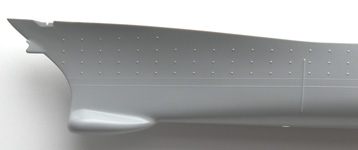 |
|
|
SPRUE B |
| This sprue contains most of decking, and also appears to
be the same as the 1/350 Panda kits. Note that the helicopter deck part
on Sprue B is an unused part in a Flight IIA. It pertains to a Flight I
or II variant (i.e. without a hangar bay), and a Flight IIA deck is included
on Sprue E. There are multiple unused parts in this kit, and it appears
that a Flight I or II could be built from this kit. |
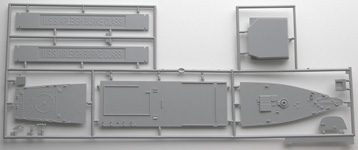 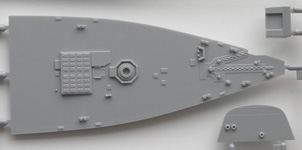
|
| SPRUE C |
| Sprue C comes in two parts. The first part of Sprue C includes
super-structure parts and details, as well as the mast. The parts contains
many molded details, such as doors, ladders, life preservers, etc. Dragon
did make one nice and noticable improvement from the Panda molds, as can
be seen in the middle photo. They "opened" a passage way, which was molded
"closed" on the Panda kits. This passage way contains no doors on the real
ships, so this is a nice improvement. |
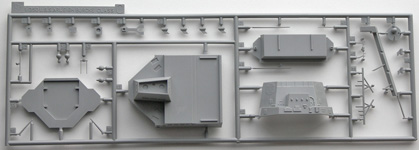 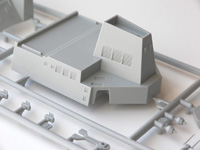 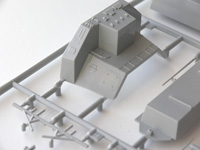
|
| The second part of Sprue C contains more super-structure
parts and details. |
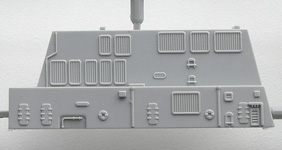 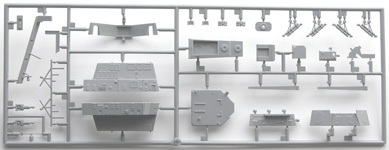 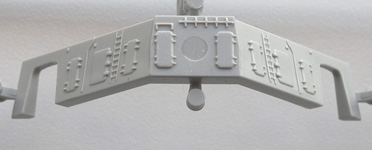
|
SPRUE D |
| This sprue contains detailed parts such as RHIB, screws,
etc. Note that Sprue D contains many unused parts which pertain to Flight
I or II variants, such as the (early) deck gun, as well as the raised exhaust
stacks (which can be seen in the uppert left of the sprue). |
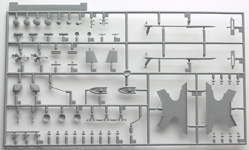 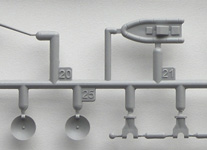
|
SPRUE E |
| The sprue contains parts that pertain only to Flight IIA
variants and sub-variants, including a hangar bay details, recessed exhaust
stacks (which started on DDG 89), new 5" deck gun (which started on DDG
81), etc. Note that the helicopter deck part contains raised line markings,
while the bow deck (Sprue B) has decal for those markings. |
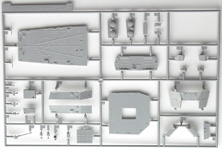 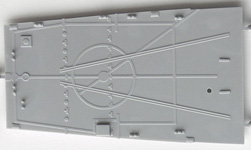 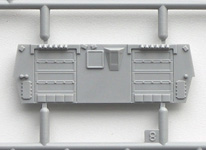
|
SPRUE F |
| This sprue contains the structure details for the Remote
Minehunting System (RMS). It should be noted that only DDG 91 through DDG
96 have this structure, and the RMS equipment has been subsequently removed
from these ships. Starting with DDG 97, the ships have a reverted design
and do not have this structure. The kit includes the option of molding
the "door" in an open or closed position. Per the webmaster of the DDG
91 website, the "door" is actually a retractable stainless steel screen.
The kit includes no details or parts for the RMS equipment, so it would
have to be scratch built if molded in the open position. |
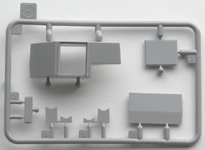 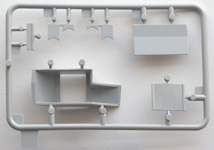
|
SPRUE H |
| This sprue contains the helicopters. |
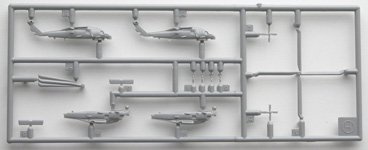 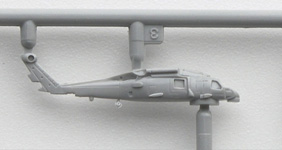
|
| PHOTOETCH |
| The photoetch fret includes railings and well as helicopter
nets. In the bottom middle part of the fret, additional details for the
mast are also included, which is a very nice addition. The fret also includes
photoetch parts for the Aegis panels. They are optional as the kit includes
molded Aegis panels on the kit parts (Sprue C). So it is supposed that
the molded panels could be removed (cut and sanded), but it might be difficult
as the parts are small. It should also be noted that the kit instructions
err in that they do not advise of considering the option of the photoetch
panels until after the superstructure of the kit is already assembled,
which would make the possibility of replacement even more difficult. |
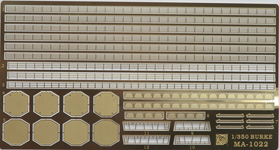
|
DECALS |
| The decal sheet includes decals for DDG 81 through DDG
85, and DDG 89 through DDG 93. |
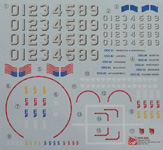 |
|
|
| INSTRUCTIONS |
|
|
|
ERROR |
| As noticed by userid "Maxim" on the message board, the
Dragon Burke kits (1/700 and 1/350) contain a signficant error in regards
to the length of the hangar bay and helicopter deck. The bay is too short
and the deck is too long. At the time of this review, I do not have access
to actual sub-measurements of a real ship. By using estimated measurements
from mutliple high-resolution photographs, it appears that the hangar bay
structure is about 0.8" too short in 1/350 scale, and likewise the helicopter
deck is 0.8" too long. It appears that the hangar bay could be extended
with stock plastic, though sanding the much of detail on the helicopter
deck might be required. The following photographs serve as reference of
the kit part measurements. |
 |
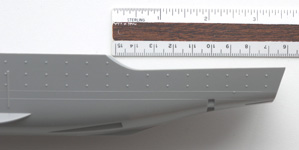 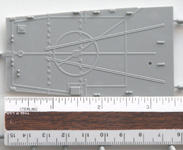 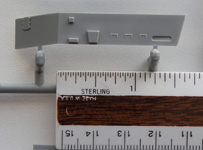 |
| This is one of several examples that would show how the
hangar bay is too short and the helicopter deck is too long. The two vertical
lines show approximately where the bottom of hangar bay doors are located
on the kit (left line) and a real ship (right line). |
 |
| This kit also serves as an example that the box art should
never be used as reference material. It depicts DDG 92 Momsen as having
CIWS, which it does not. |
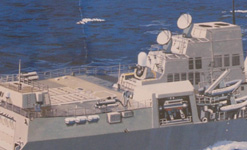 |
CONCLUSIONS |
| For anyone wishing to build a modern Burke variant in 1/350,
it appears that the Dragon DDG 92 Momsen can serve as a good basis. It
also includes photoetch parts and high quality decals. So building it out
of the box should result in a nice looking model. The more discriminating
modeler may elect to fix the hangar bay length. Given the "squareness"
of the structures involved, it appears that such an effort would not be
all that difficult. |
 |


